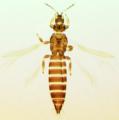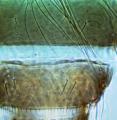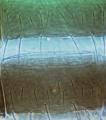Thrips vulgatissimus
Recognition data
Distinguishing features
Both sexes fully winged. Body and legs brown, tarsi and antennal segment III yellow; fore wings pale. Head as wide as long; cheeks convex, 2 pairs of ocellar setae; pair III arising on anterior margins and slightly longer than side of ocellar triangle; postocular setae pairs I & III shorter than ocellar setae pair III, pair II minute. Antennae 8-segmented; segments III–IV with sensorium forked. Pronotum with 2 pairs of long posteroangular setae; posterior margin with 3 (sometimes 4) pairs of setae. Metanotum with parallel lines of sculpture medially converging at posterior; median setae arising near anterior margin; campaniform sensilla present. Fore wing first vein with 3 setae on distal half; second vein with complete row of about 14 setae. Abdominal tergite II with 3 lateral marginal setae, V–VIII with paired ctenidia, on VIII posteromesad to spiracles; tergite VIII posteromarginal comb complete, microtrichia long; pleurotergites with 3–4 discal setae. Sternite II with 2 pairs of marginal setae, III–VII with 3 pairs; sternite II with few discal setae, III–VII with 15 to 20 discal setae in irregular double row.
Male smaller than female; tergite VIII without posteromarginal comb; sternites III–VII with broadly transverse pore plate in front of discal setae.
Related and similar species
The genus Thrips is the second largest genus in the Thysanoptera, and currently includes, worldwide, about 285 species. T. vulgatissimus is unusual amongst North American members of this genus in having discal setae on the pleurotergites as well as the sternites. T. pruni Nakahara was described as closely similar, based on two females collected in California but with slightly darker tibiae and only two pairs of pronotal posteromarginal setae. In Europe T. vulgatissimus is very similar to T. meridionalis Priesner, a common pest of stone fruits in parts of the Mediterranean region. All members of genus Thrips lack ocellar setae I on the head, and they all have ctenidia on tergite VIII posteromesad to the spiracles. Other characters, such as number of antennal segments, number of setae on the fore wing veins, and number of discal setae on the sternites are variable between species (Palmer, 1992; Nakahara, 1994; Mound & Masumoto, 2005).
Taxonomic data
Current valid name
Thrips vulgatissimus Haliday
Original name and synonyms
- Thrips vulgatissimus Haliday, 1836: 447
- Physopus pallipennis Uzel, 1895: 110
- Taeniothrips lemanis Treherne, 1924: 87
- Taeniothrips vulgatissimus f. gracilis Priesner, 1926: 298
- Taeniothrips vulgatissimus f. atricornis Priesner, 1926: 298
- Taeniothrips americanus Moulton, 1929: 130
- Physothrips gentianae Bagnall, 1933: 653
- Taeniothrips tahvanus Hukkinen, 1936: 139
Family placement
Thripidae, Thripinae
Biological data
Life history
Breeding in flowers.
Host plants
Apparently polyphagous, but particularly associated with white flowers including various Rosaceae.
Tospoviruses vectored
None
Crop damage
None
Distribution data
Area of origin
Holarctic or possibly Western Europe.
Distribution
Widespread across Europe, also northern and western areas of North America.








